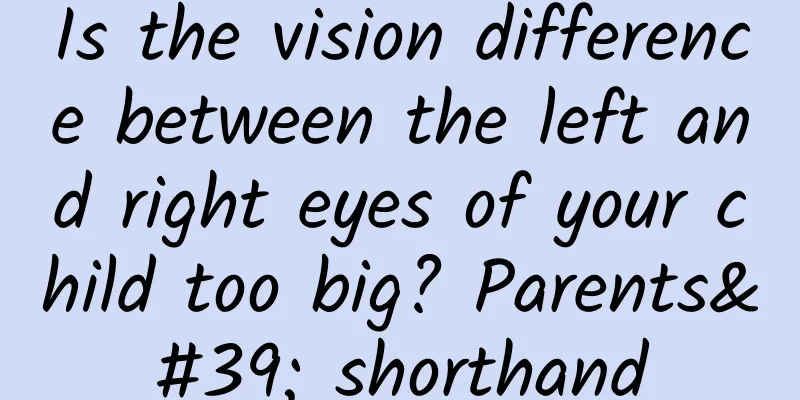Is the vision difference between the left and right eyes of your child too big? Parents' shorthand

|
"What? My child is nearsighted and his two eyes are different!" "One eye has 0.8 vision, and the other eye only has 0.5?!" "My child's myopia degree is different in his two eyes. Is there a problem?" In fact, this situation is called anisometropia. Anisometropia refers to the different refractive states of the two eyes, that is, the degree of refractive error in the two eyes and the nature of the two eyes are different, which we can call anisometropia. To put it simply, the two eyes need to wear lenses with different degrees and the accommodation power of the two eyes is also different. Why does anisometropia occur? 1. Unbalanced development of the eyeballs of both eyes We mentioned earlier that everyone’s body parts are not completely symmetrical and there may be certain differences. The same is true for the development of the eyeball. This unbalanced development may lead to different refractive powers of the two eyes, thus causing anisometropia. 2. Differences in the process of recognizing Children's vision development is a complex process that is affected by many "environmental factors". Anisometropia may also occur if the vision in each eye does not progress in sync. 3. Eye habits Tilting the head, looking at things while lying on your side, and incorrect writing posture may also cause anisometropia. 4. Genetic factors Genetic factors play an important role in many eye diseases. If someone in your family has had anisometropia, your child may be at risk of inheriting the condition. 5. Trauma, eye surgery or eye disease Trauma or surgery to the eye may affect the shape and structure of the eye, thereby changing the refraction. For example, surgeries such as artificial lens implantation and corneal transplantation may cause refractive errors. Many eye diseases, such as ptosis, eyelid hemangioma, congenital cataract, keratoconus, etc. All of these may affect the refractive state of the eyeball, thus causing anisometropia . 2. What are the dangers of anisometropia? 1. Affect the quality of daily life When there is a large disparity between the vision of a child's two eyes, they may have difficulty looking at the same object. This can cause them to have problems reading, writing, watching television or using electronic devices, affecting the quality of their daily life. 2. Increase eye fatigue In order to see clearly, children may try to tilt their heads to one side or focus by squinting, frowning, etc. These actions can cause eye fatigue and discomfort. 3. Hindering learning and cognitive development Vision problems can affect your child's learning outcomes. If the vision in one eye is poor, children may have difficulty learning or completing homework, which may affect their academic performance. 4. Affects body shape and posture Children may tilt their heads or move away from the screen to see more clearly. These habitual movements may affect their posture and position, and may even lead to cervical spine problems. 5. Lack of stereoscopic vision If the difference in vision between the two eyes is too great, the brain cannot synthesize the images of the two eyes, and the two eyes will be used alternately. Only one eye is used at a time, which is equivalent to seeing objects with one eye. Poor stereoscopic vision will lead to inaccurate positioning, which will have a certain impact on situations such as doing fine movements and driving. 3. How to treat anisometropia? 1. Frame glasses For children, frame glasses need to be fully corrected and worn all day to consolidate their binocular vision and prevent the occurrence of strabismus and amblyopia. For children with anisometropia and amblyopia, amblyopia can be treated by wearing frame glasses combined with occlusion therapy, suppression therapy and visual training. 2. Contact lenses When the refractive difference between the two eyes is large, in order to avoid the unequal image problem caused by frame glasses, the patient can wear corneal contact lenses. For patients with myopic anisometropia, the myopia of the worse eye will increase too quickly. OK lenses can effectively slow down the growth of the axial length of the eye with higher myopia, prevent the axial length difference between the two eyes from becoming larger and larger, and aggravate the degree of anisometropia. Anisometropia should not be ignored! Early detection, early intervention and early treatment are necessary. Children and adolescents should undergo a comprehensive eye examination every three months or six months to promptly detect vision and visual function problems in their children, and conduct vision correction training as early as possible. Do not miss the best time for treatment. |
Recommend
Menstruation is only accompanied by urine discharge
During menstruation, women's menstrual blood ...
How to effectively reduce swelling of Bartholin's gland?
Bartholinitis often occurs in women of childbeari...
What are the treatments for cervical erosion?
Patients with cervical erosion are mainly women w...
What slows down aging?
As time goes by, our bodies will gradually age, o...
What is a double uterus?
Double uterus is a relatively common condition in...
What is the cause of female endocrine disorders?
Regarding the problem of female endocrine disorde...
What is the difference between pineapple and pineapple? Are pineapple and pineapple the same fruit?
Pineapple and pineapple are different varieties o...
When is Li Jiaqi's 2020 New Year Goods Festival? Li Jiaqi's January 5 New Year Goods Festival live broadcast preview
Li Jiaqi's live broadcast room will launch di...
What should I do if my cat has rotten lips? What should I do if my cat has pimples inside its mouth?
Cats are pets that many people keep. When raising...
Can I have sex the day before my prenatal checkup?
Pregnancy check-ups are necessary during pregnanc...
IDC: Global AR/VR headset shipments reached 11.2 million units in 2021, a year-on-year increase of 92.1%
According to IDC, AR/VR headset shipments grew si...
What foods can help maintain your stomach?
Nowadays, many people often do not eat at mealtim...
Follow-up and treatment principles of esophageal precancerous lesions
Esophageal precancerous lesions are abnormal chan...
What is the cause of painful urination with blood?
It is very painful when urinating, and this pheno...
How to treat lactation mastitis?
Mastitis is caused by an infection of the breast....









